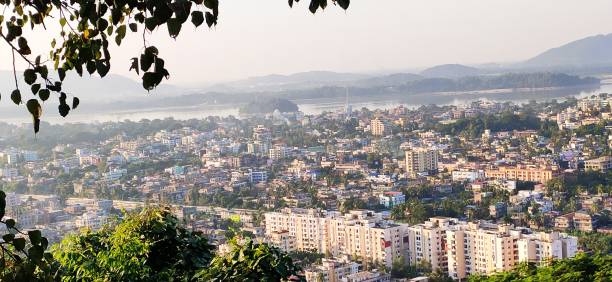Guwahati, Feb 20: A study using a dense network of low-cost air quality sensors has revealed that Guwahati’s winter PM2.5 pollution peaks at 113.05 µg/m³, nearly three times higher than India’s safe limit of 40 µg/m³ and 2.8 times above the NAAQS 24-hour threshold of 60 µg/m³.
Conducted by IIT Kanpur researchers, the study found that winter pollution levels in Guwahati are over four times higher than during the monsoon season (32.36 µg/m³). A significant 47% of the pollution originates from the Indo-Gangetic Plain (IGP) and 32% from Bangladesh, highlighting the major role of transboundary air pollution in worsening air quality.
Key Findings of the Study
🔹 Severe Seasonal Variation: Guwahati’s winter pollution is over 4X higher than in the monsoon months.
🔹 Transboundary Pollution: 47% of pollutants come from IGP, 32% from Bangladesh, worsening air quality.
🔹 Meteorological Triggers: Low temperatures, stagnant air, and a shallow boundary layer trap pollutants closer to the surface, aggravating pollution.
🔹 Pollution Hotspots Identified: Areas along NH-27, industrial zones, and high-traffic commercial areas experience the worst air quality.
Policy Interventions Needed to Tackle Crisis
The research underscores the urgent need for targeted air quality management strategies in Guwahati, including:
✔ Stricter industrial emission controls in pollution hotspots.
✔ Green buffer zones to absorb PM2.5 concentrations.
✔ Public health advisories during peak pollution months.
✔ Tighter controls on traffic emissions and waste burning.
“This study confirms that Guwahati’s air pollution is not just a localized problem but heavily influenced by transboundary air masses from IGP and Bangladesh,” said Prof. Sachchida Nand Tripathi, Corresponding Author of the study and Expert Committee Member for NCAP, IIT Kanpur.
The study, published in Environmental Monitoring and Assessment (Springer Nature), is titled “Influence of Seasonal Variation on Spatial Distribution of PM2.5 Concentration Using Low-Cost Sensors.” It was conducted under the ATMAN Initiative, supported by Ericsson India, Bloomberg Philanthropies, Clean Air Fund, and Open Philanthropy.
By deploying Atmos real-time air quality sensors, developed by Respirer Living Sciences, India, researchers created the most detailed air pollution map of Guwahati to date, tracking PM2.5 levels from July 2022 to June 2023.
“By using a dense sensor network, we pinpointed hyperlocal pollution sources that were previously undocumented. This level of monitoring is essential for targeted interventions,” said Ronak Sutaria, CEO & Founder of Respirer Living Sciences.
With Guwahati’s winter air pollution reaching alarming levels, experts emphasize the need for immediate action to safeguard public health and improve air quality in the region.
Also Read: Don’t misinterpret Religion Act: Pema Khandu urge Christian Forum
Also Watch
Find latest news from every corner of Northeast India at hubnetwork.in, your online source for breaking news, video coverage.
Also, Follow us on-
Twitter-twitter.com/nemediahub
Youtube channel- www.youtube.com/@NortheastMediaHub2020
Instagram- www.instagram.com/ne_media_hub
Download our app from playstore – Northeast Media Hub





